The Black residents fighting Atlanta to stay in their homes
After decades of discrimination, racial injustice and systemic neglect, four households are resisting the city’s efforts to remove them from their homes and gentrify their historically Black neighbourhood.
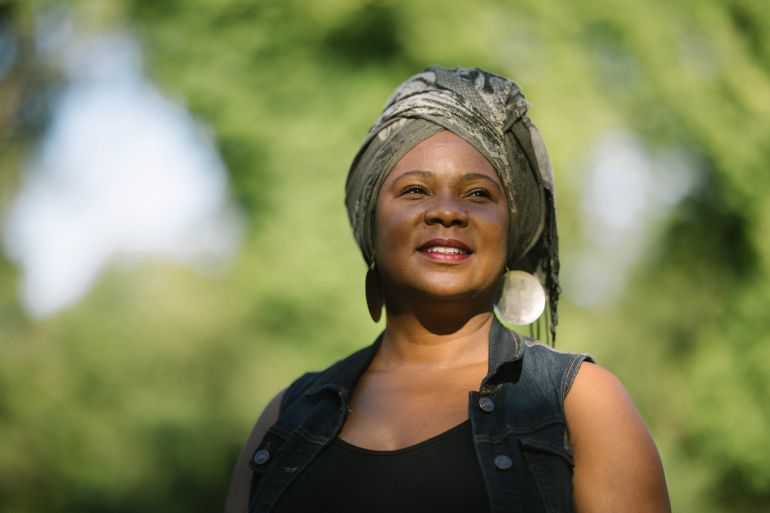
Atlanta, Georgia – Tanya Washington remembers moving into Peoplestown, a predominantly working-class and historically Black neighbourhood about two miles southeast of Atlanta’s downtown, a decade ago.
Across the street from her home was an old Black church, which residents say was at least half a century old. “I moved in on a Saturday,” recalls the law professor at Georgia State University, who is originally from Washington, DC.
Keep reading
list of 4 itemsThe weight and pressure of American racism
Moment of Reckoning: Racism and Police in America
An American lynching: ‘I could hear their screams’
She is sitting in the living room of her 100-year-old home, where she lives with her husband and two children, aged four and 18. A television plays muted footage of Black Lives Matter protests in the city; book-lined shelves add cosiness to the room decorated with framed family portraits on the blue walls.
“On Sunday morning when I woke up, I heard the sounds of old spirituals like my grandmother used to sing in her choir when I would visit her in South Georgia,” the 50-year-old recalls.
“I was thinking ‘What is going on?’ I thought maybe the Lord was calling me home; maybe I died and didn’t even realise it.”
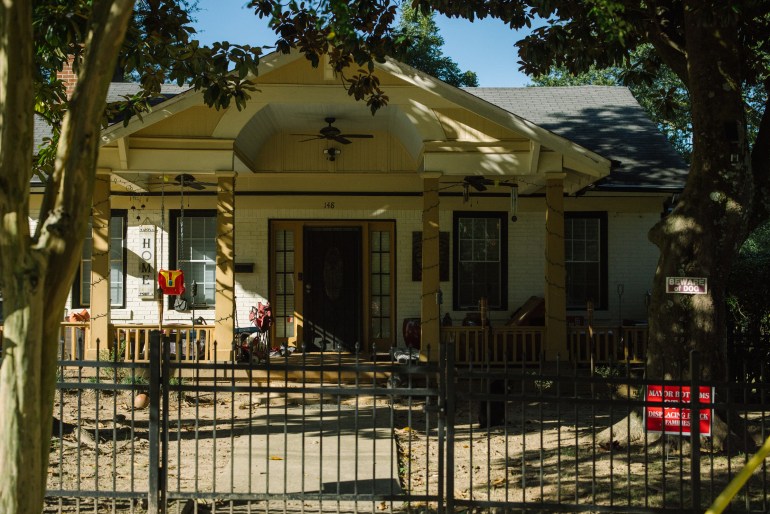
She chuckles at this memory of a neighbourhood that quickly became her home. “It was a beautiful church. I thought how incredible it was that I got to wake up and listen to this every Sunday morning.”
But the scene she describes bears no resemblance to the cookie-cutter suburban houses that now sit across the street, where the old church once stood. The songs that spilled into Washington’s bedroom with the sunshine each Sunday morning have been replaced with silence.
About two years ago, the church’s owners sold the building to private realtors, who, driven by the city’s development plans, have targeted Peoplestown over the past few years. The pews were moved out onto the lawn, from where they were sold, one by one.
Washington watched as the church was demolished and residential homes were built in its place. It was not an unusual sight in a neighbourhood where at least every other home has been sold off, renovated or demolished and replaced with a larger, more expensive house.
The newcomers trickling into Peoplestown to settle in these properties are more affluent, and often whiter, than the mostly working-class residents who lived in the neighbourhood for many decades.
“The noises are different. The people are different. The whole environment of the neighbourhood is completely different now,” Washington says.
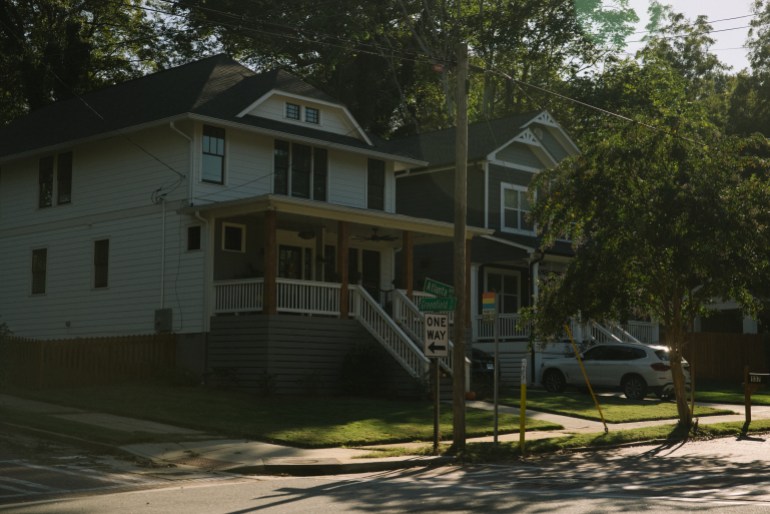
It is a process of gentrification that has already transformed the city of Atlanta – and major cities across the US – intertwining with unresolved racial injustices built into the country’s foundations and resulting in mass displacement of low-income and Black residents.
Peoplestown is one of the last historically Black neighbourhoods to be targeted for gentrification in Atlanta, which has one of highest rates of income inequality in the US and was the fourth-fastest gentrifying city in the country between 2000 and 2014. But while it arrived later than in other parts of the city, when gentrification came, it came with force.
‘Stop displacing Black families’
In 1974, Atlanta became the first major southern city to elect an African American mayor, and every mayor since has been African American. The city celebrates itself as home to scores of civil rights leaders, including Martin Luther King Jr and John Lewis. Its numerous Black-owned businesses and its strong Black middle and upper class have earned the city the title of America’s “Black Mecca”.
But this carefully constructed image clashes sharply with the bright red signs staked into the lawns on Washington’s block, where just four homes remain where once at least two dozen had stood.
“Mayor Bottoms, stop displacing Black families,” one of the signs reads, referring to Atlanta’s current mayor, Keisha Lance Bottoms. “Stop predatory use of eminent domain,” is printed onto another.
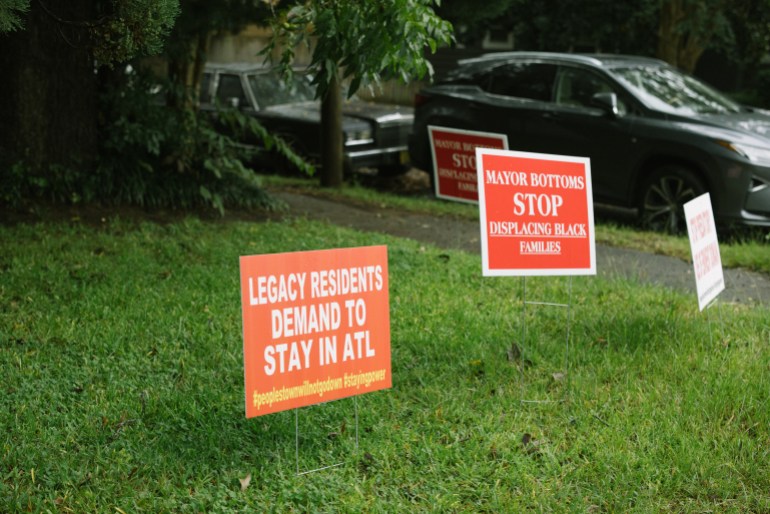
In 2012, a series of storms resulted in severe flooding on Washington’s block, as runoff rainwater overwhelmed a combined water and sewage system built beneath it and caused a major overspill. At least six homes were damaged.
The city covered the costs of cleaning and repairing the damaged homes, at least one of which was flooded with several inches of sewage, as the city’s failure to upgrade the system had caused the overspills. But residents say the city did not finish all the repairs and in response several residents sued.
About a year later, in 2013, the city offered to buy the damaged homes as part of a settlement with the families and in order to construct a pond on the location of the overspill to mitigate flooding in the neighbourhood. The city allegedly told the residents that if they did not accept the city’s offer, they would end up receiving far less in the future and warned them the city was planning to eventually take the whole block of homes anyway.
While a few of the families settled with the city at this time and parted with their homes, most opted to refuse the city’s offers and stay. In 2014, however, the city approved the use of “eminent domain” – which allows the government to expropriate private property for public use – to construct a pond and park at the site. In 2015, the other families on the block received letters from the city informing them it would need to acquire their properties.
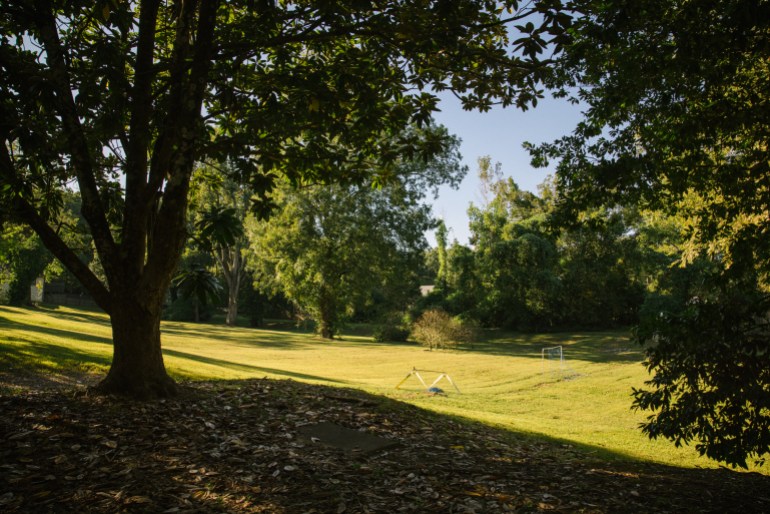
In place of their homes, it planned to develop a $65m green infrastructure project that is expected to include a Japanese garden, gazebos, several retention ponds and bioretention areas to treat stormwater.
The decision altered the lives of the families on the block, most of whom buckled under the threat of the city’s eminent domain ordinance and gave up their homes. Residents who settled with the city were made to sign non-disclosure agreements banning them from sharing the amount they had agreed on with other residents.
There is still no pond or park in Peoplestown, but the planned project has already transformed the neighbourhood. Washington’s and just three other homes remain; all the others have been demolished and replaced by open green space.
“It just didn’t feel right,” Washington reflects. “My house was never damaged from the flooding. How do you go from wanting to buy a few homes to suddenly needing to take an entire block?”
She suspected the city was abusing eminent domain to drive private investment in the neighbourhood so, along with a handful of other residents, she decided to challenge it.
What followed offered them an insight, they say, into the institutional racism and alleged corruption that has shaped Atlanta’s gentrification.
Decades of discrimination, racial injustice, and systematic neglect of low-income and Black neighbourhoods may have sealed the fate of Peoplestown long before the 2012 flood, but the residents of these four homes are determined to stay put.
White flight
The civil rights movement of the 1950s and 1960s – when Black Americans challenged the system of segregation commonly known as “Jim Crow” that was designed to limit their rights after centuries of slavery – was accompanied by a process of white flight from the inner cities.
It was no different for Atlanta, even as, from the 1950s on, it referred to itself as the city that was “too busy to hate” and local leaders worked to build an image of the city as one of economic prosperity and racial progress.
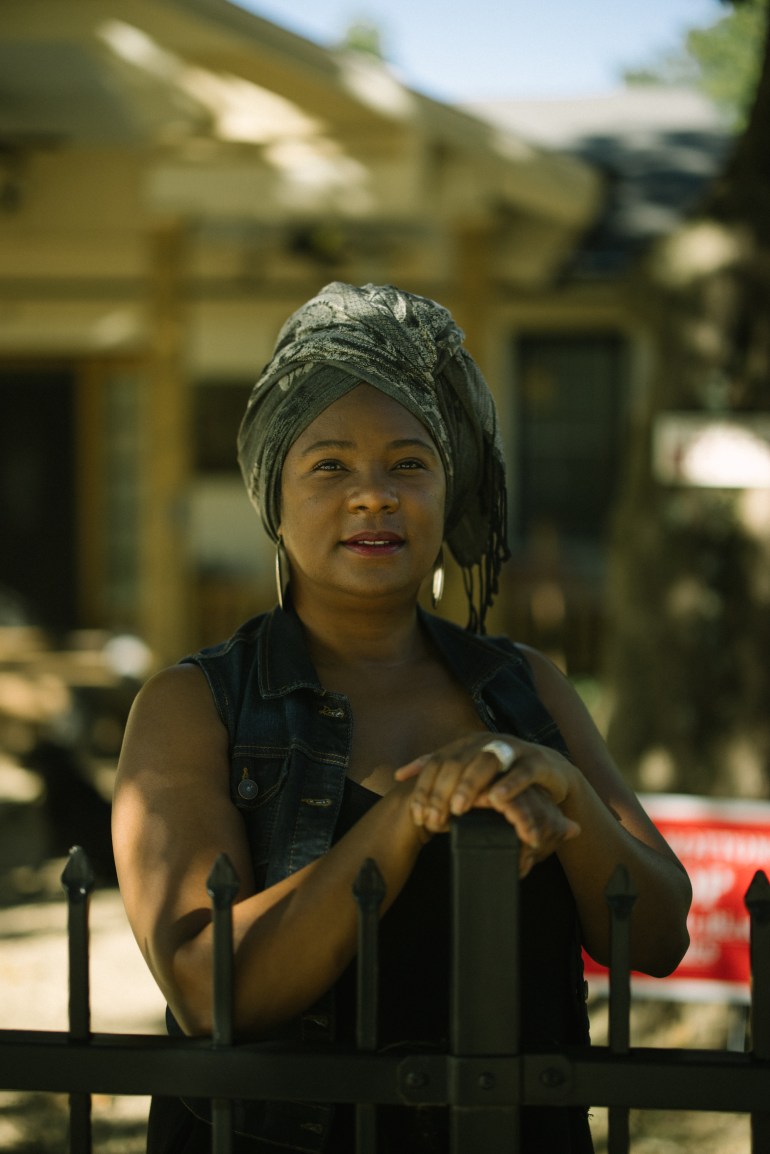
According to Kevin Kruse, professor of history at Princeton University who wrote a book on the white flight from Atlanta during desegregation in the 1950s and 60s, when African Americans were permitted to expand from the congested neighbourhoods they had been consigned to into formerly all-white parts of the city, they were threatened by white supremacists and their homes were bombed. But when terror campaigns and pleas to public officials failed, white residents packed up, sold their homes and deserted the city entirely.
By the 1970s, white people, with the help of government homeowner schemes that were denied to African Americans, had abandoned the inner cities en masse and established communities in the suburbs, with the aim of maintaining all-white neighbourhoods.
Since the country’s inception, wealth disparities have been shaped by racial injustices and discrimination. In 2016, the net worth of a typical white family was nearly 10 times greater than that of a Black family, according to the Brookings Institution, an American think-tank. So when white people left the inner cities, capital quickly followed.
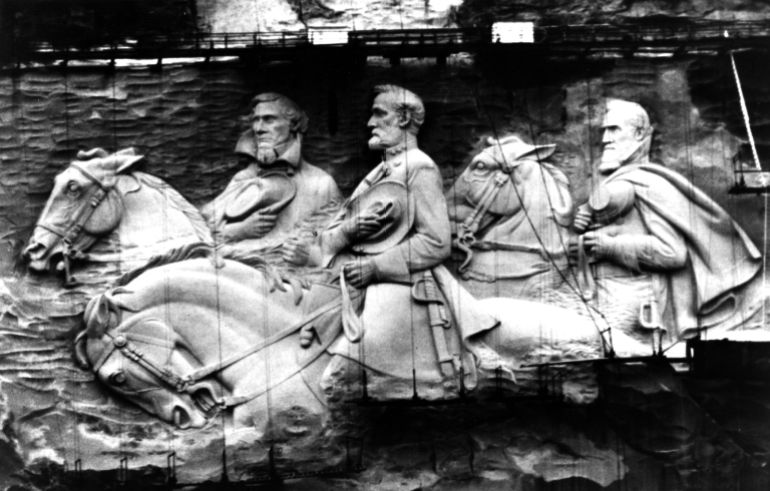
Tea Troutman, an urban development researcher and Atlanta-based community organiser, tells Al Jazeera that as capital moved to the suburbs, industries and jobs that working-class city residents were dependent on followed suit. While it was predominantly white people leaving the cities, “affluent flight” also added to the capital drain, as higher-income Black and brown residents also left, Troutman says.
“Deindustrialisation happened at the same time as capital flight, turning cities into these destitute spaces,” Troutman explains.
Austerity policies were then rolled out in the latter part of the 1970s and accelerated in the 1980s when former US President Ronald Reagan slashed federal aid to cities; this resulted in dramatic cutbacks to social programmes that scores of already marginalised communities relied on and exacerbated social and economic issues in the cities.
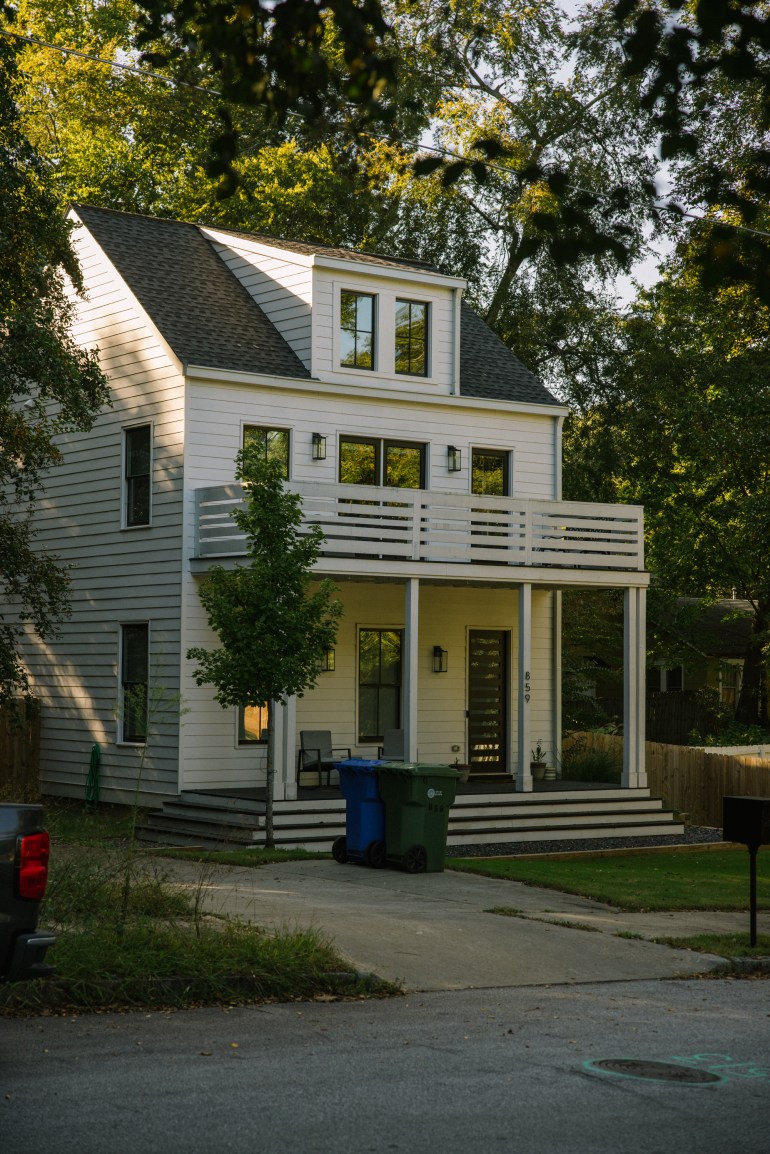
Over the past several decades, cities have attempted to attract outside investment to transform urban neglect and decay into development and renewal by luring wealthier and predominantly white people to return to the inner cities in order to increase the city’s tax base – especially in the form of sales and property taxes, which are major sources of revenue for local governments.
But as has become clear to some residents of Peoplestown, urban development and economic progress often begets displacement, dispossession, and increased violence for Black and low-income city residents.
‘Urban renewal means negro removal’ – James Baldwin
Peoplestown’s residents are all too familiar with the unjust patterns of urban development.
When city officials wanted to link downtown Atlanta to the expanding white suburbs in the 1950s, three major interstates were constructed in Peoplestown, Summerhill and Mechanicsville, ripping through the heart of these long-established communities and separating the sister neighbourhoods from each other.
In 1957, the city conceived of another urban renewal plan and bought up about 600 acres of land in portions of Summerhill, Mechanicsville, and Peoplestown, removing thousands of Black residents and closing more than 100 Black-owned businesses in order to make room for housing, businesses, schools and parks that would attract middle-income – largely white – families.
According to Larry Keating, a professor of city and regional planning at Georgia Tech Research Institute, the project was designed to also create a buffer between the low-income Black neighbourhoods and the central business district in one of many attempts to keep Atlanta’s downtown a desirable location for middle-class white people by expelling Black residents from the area.
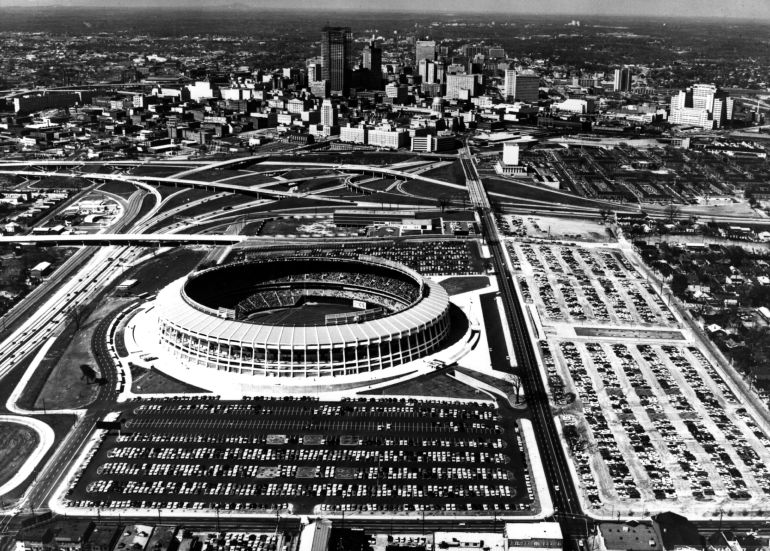
The project, however, never came to fruition and the massive lot of land stood vacant until 1964 when Ivan Allen Jr, Atlanta’s mayor at the time, decided to build a stadium, now the Atlanta-Fulton County Stadium. Keating says the plan was likely envisaged to thwart community proposals to use the land for building public housing for low-income Black residents.
The trumpets of urban renewal and economic growth once again reverberated through the city while more Black residents saw their homes demolished for extra parking spaces around the stadium.
In 1966, the body of Harold Prather, an unarmed Black man, collapsed along with the homes, after a white police officer shot and killed the 25-year-old in Summerhill. Prather was stopped on a traffic violation and informed of an open warrant for his arrest. The young man ran from the police, who responded by shooting him in the hip and side.
Frustrations in the neighbourhood, which was settled in 1865 by formerly enslaved African Americans, had reached their boiling point and days-long protests and rioting erupted. When Mayor Allen attempted to pacify the protests by standing atop a police patrol car and speaking to the angry crowd through a megaphone, he was met with bricks, stones and bottles. The crowd drowned out his pleas for law and order by chanting “Black power! White devil!”
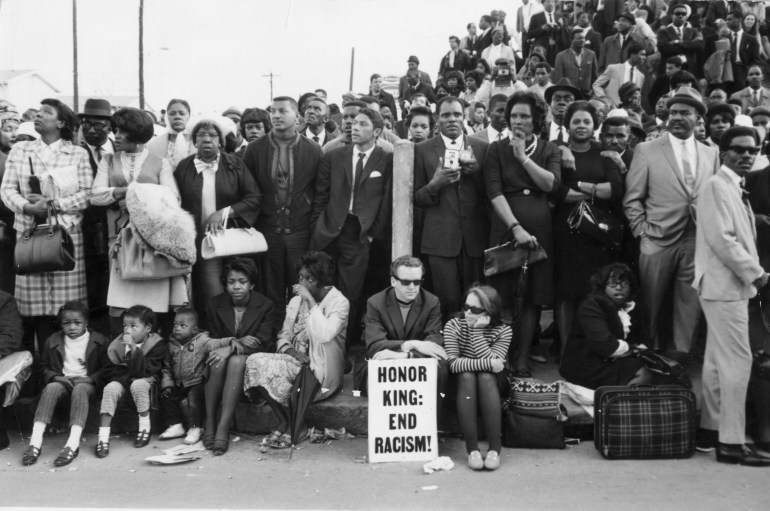
This process was replayed in cities across the United States. James Baldwin, the celebrated writer and activist, put it bluntly in 1963: “Urban renewal means negro removal.”
Following the same trend, in the 1990s, as Atlanta prepared to host the Olympic Games, the city once again took to bulldozers and demolished its public housing. Atlanta was the first American city to introduce public housing in 1935 and by 2011 it was also the first to have demolished all of it.
When the renewal plans for Atlanta’s dilapidated public housing were introduced, the low-income Black residents were promised affordable housing units in the new mixed-income apartments that were to be built on top of the rubble of their former homes.
But stringent screening processes, which barred low-income residents from returning if someone in their household had a criminal record or they did not have full employment, made it so very few displaced residents were permitted to return. Others received Section 8 vouchers, which subsidise costs in the private housing market; but which also limit the areas recipients can live in depending on which landlords accept the vouchers.
Many former public housing residents who were not eligible to return were made homeless. According to Troutman, some parts of Atlanta where public housing once stood are now gentrified and are the most expensive parts of the city, while other areas still remain completely vacant since the housing was demolished.
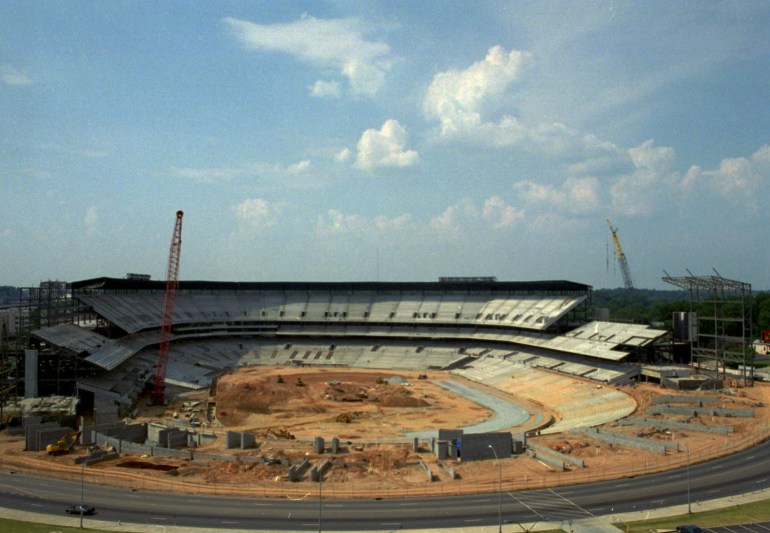
In the years leading up to the Olympics in 1996, city leaders once again loudly touted economic progress and marketed Atlanta as the cradle of the civil rights movement, while promising enormous benefits for the community. At the same time, roughly 30,000 low-income residents were evicted or displaced from the city.
The city moved to clean the streets of anything that contradicted the glossy spectacle of an up-and-coming international hub that Atlanta’s leaders intended to portray to the world. Thousands of homeless people, most of them African American, were unlawfully arrested and thrown into the newly built Atlanta City Detention Center, where their poverty would not distract from the city’s newly polished image.
The city allocated more land for the construction of the Centennial Olympic Stadium, located adjacent to the Atlanta-Fulton County Stadium, adding more displaced Black residents to the thousands who were expelled decades earlier. Peoplestown once again felt the heavy burden of Atlanta’s development.
According to Haythem Shata, an Atlanta-based civil engineer, the area where the Olympic Stadium – now called Turner Field – was to be built was plagued by historic flooding, documented from at least the 1950s, as the location was the site of a stream through which a large amount of run-off drainage passed.
The city, therefore, constructed two culverts, or channels, from the two major interstates to redirect the run-off water into a junction box located underneath Peoplestown’s now-contested block to divert flooding from around the Olympic Stadium, says Bill Eisenhauer, an Atlanta-based engineer and analyst from the Metropolitan Atlanta Urban Watershed Institute.
The junction box was already the site where at least 145 kilometres (90 miles) of combined sewer lines join, before releasing into a large trunk line that runs partly down Atlanta Avenue, where Washington’s home is located, and into a combined sewer overflow basin and eventually into a wastewater treatment plant.
According to Eisenhauer and residents who lived in the neighbourhood at the time, before constructing the culverts to reroute the streams to Peoplestown, the Georgia Department of Transportation had assured the communities that a relief trunk line would be constructed from the junction box in Peoplestown, through Grant Park – a wealthier and predominantly white community located about two miles from Peoplestown, and into the nearby combined sewer overflow basin – in order to relieve the pressure on the combined sewer and water system in Peoplestown.
But the relief trunk was never built. “They [the city] thought it was better to disrupt the lives of the poor and Black neighbourhood rather than the wealthy and white neighbourhood,” says Columbus Ward, a prominent neighbourhood advocate and longtime resident of Peoplestown.
Despite the dramatic increase of water flow into the junction box, the city did not build additional stormwater storage capacity upstream from Peoplestown or add the relief trunk, Eisenhauer explains, causing the system to get overwhelmed during storms – the pressure of which results in the lids of the junction box and manholes popping off and sewage spilling out into the neighbourhood.
Since Peoplestown sits on a low basin, the more the city was built up after the Olympics, the more Peoplestown was inundated with stormwater runoffs from the concrete that smothers the ground of the city. “We have all of this development happening around us, but we still have that same stormwater sewage system that was not made to accommodate this much growth,” Washington explains. “So we end up with floodings.”
After the 2012 flooding in Peoplestown, Kasim Reed, Atlanta’s mayor at the time, had hired a national consulting firm to estimate the cost of constructing the relief trunk line, according to Eisenhauer. But nothing came of it, likely because the construction of the trunk line would be too costly, Eisenhauer says.
According to residents, the city also fails to adequately clean the drains, which has compounded the problem. “The city has created a problem and then they use that problem to further gentrification and displace us from our homes,” Washington says.
‘A runaway train’
A large cement lid, where the junction box is located and the source of the overspills, is perched atop the expansive grass stretching across Washington’s block, and sits in the backyard of Bertha and Robert Darden, an elderly couple who have lived in Peoplestown for three decades. Their quaint brick house is adjacent to Washington’s on the other end of the Atlanta Avenue stretch of the block.
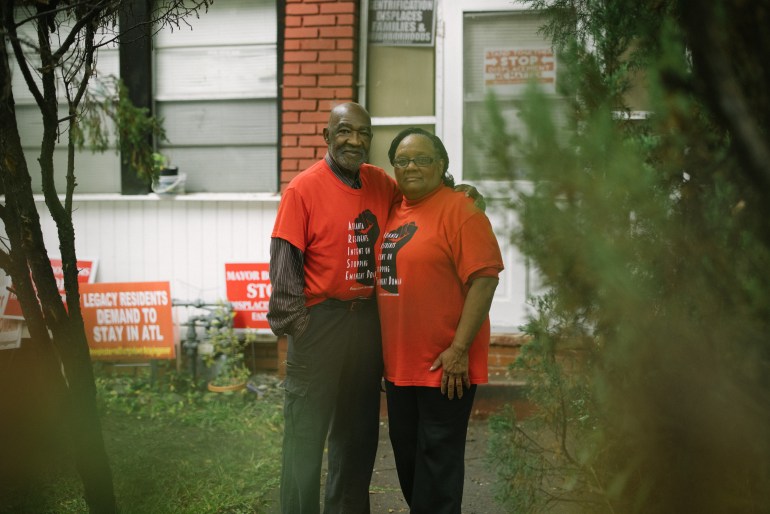
“I knew right when I saw this house that this was the one; this was where I was going to raise my children and build a family,” Robert, 70, tells Al Jazeera. His living room is blanketed in a patchwork of framed photographs of his children and grandchildren; it feels like walking inside a family photo album.
“The neighbourhood wasn’t as safe back then as it is now. But it had everything that I needed,” adds Robert, who had worked as an engineer for the city for decades. His home is also located walking distance from the Greater Christ Temple Holiness Church, where he has attended service since 1975 and where he met and fell in love with Bertha.
Their home was one of the houses damaged in the flooding in 2012. Sixty-five-year-old Bertha immediately feared that forcible displacement might follow.
The Dardens, along with the rest of Peoplestown, have watched as neighbourhoods around them have transformed over the last decade and a half; each following the same trend: Black and low-income residents pushed out while wealthier and mostly white residents replaced them.
In 2005, the BeltLine was conceived and “exacerbated this cycle of gentrification that was already on a runaway train,” Troutman tells Al Jazeera. The multibillion-dollar megaproject will ultimately connect 45 neighbourhoods to a 22-mile (35-km) loop of multi-use trails, parks and eventual street cars that follow abandoned railroad tracks that loop around the perimeter and throughout the core of Atlanta.
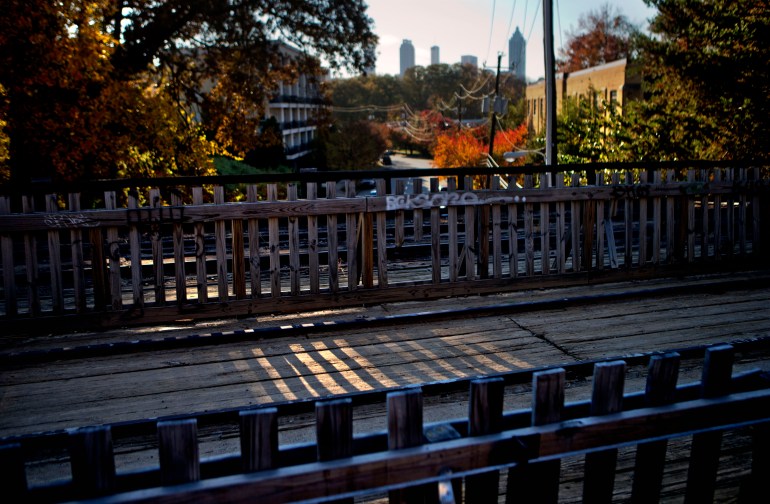
The BeltLine, which is expected to be completed in 2030, is touted as a project to improve transportation, establish green spaces and promote development – and has become a major driver of gentrification in Atlanta.
The canopies of trees along the BeltLine shade the winding trails that slither through parks, upscale residential neighbourhoods and commercial areas lined with craft breweries, restaurants, and luxury apartments; city residents can bike to work or around the city on the trail. The project has painted a picturesque and charming image for the young and affluent professionals the city wants to attract.
But it has brought another wave of displacement for surrounding low-income and largely Black communities, triggering sharp increases in home values – pushing out low-income renters who cannot afford the jump in rent and homeowners who cannot afford the increased property taxes.
Old Fourth Ward, considered the “ground zero” of the BeltLine’s development, was an historic Black neighbourhood in the heart of Atlanta with a rich and vibrant history; it is the birthplace of Martin Luther King Jr and the home of the famous Ebenezer Baptist Church, where he served as pastor up until his assassination in 1968.
The neighbourhood, which is situated along the eastside trail, is now used as a precautionary tale for other Black neighbourhoods bracing for the hardships that follow in the BeltLine’s path.
While Old Fourth Ward was neglected for decades, nowadays large multi-storey homes, townhomes and condos are built alongside old shotgun houses, while some of the city’s most popular restaurants and bars are located in the area. Street art is splashed around the neighbourhood, with a mural of George Floyd painted onto the side of a building and, just down the street, another building has “Black Futures Matter: End Mass Incarceration” etched across its length.
Like other neighbourhoods around the BeltLine, the Black population in Old Fourth Ward has steadily declined, while the white population continues to increase. In 2000, 76 percent of the 12,444 residents in the neighbourhood were Black and just 16 percent were white.
In 2015, however, the population had increased to 14,321 people, but the Black population had shrunk to 49.5 percent and the white population rose to 39 percent. Over the same period, median household income had more than doubled, from $19,614 to $42,627.
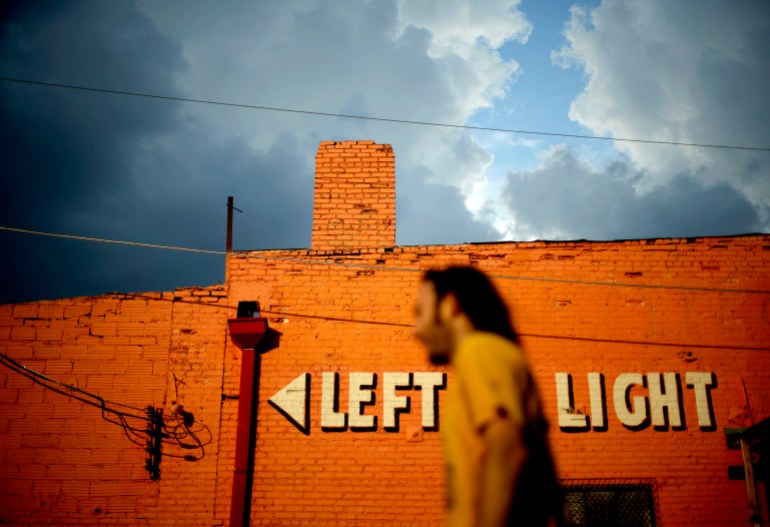
Along the Southwest segment of the BeltLine, which the city broke ground on earlier this year, surrounding neighbourhoods, which includes Mechanicsville, saw median sale prices jump 68 percent between 2011 and 2015. Peoplestown is also located on the south end of the BeltLine.
According to Troutman, the housing market collapse in 2008 added gasoline to the fire that was already ripping through Atlanta. The city, which has a strong legacy of Black homeownership, was hit hard. About a quarter of a million residents lost their homes to foreclosures and many others were targeted by private investors who swooped in to take advantage of the crisis.
“You saw a lot of people being approached to sell their homes around this time,” recalls Ward, the neighbourhood advocate. “And this was when a lot of people were vulnerable to selling their homes because they could no longer afford them.”
“We also saw a lot of city code enforcers coming around at this time,” he adds. “They would tell people who already couldn’t afford their taxes and bills that they had to paint their houses or install a new roof. It almost seemed like everyone was just coming together for the sole purpose of kicking people out the neighbourhood.”
But nothing prepared Peoplestown’s residents for the drastic changes that were about to take place.
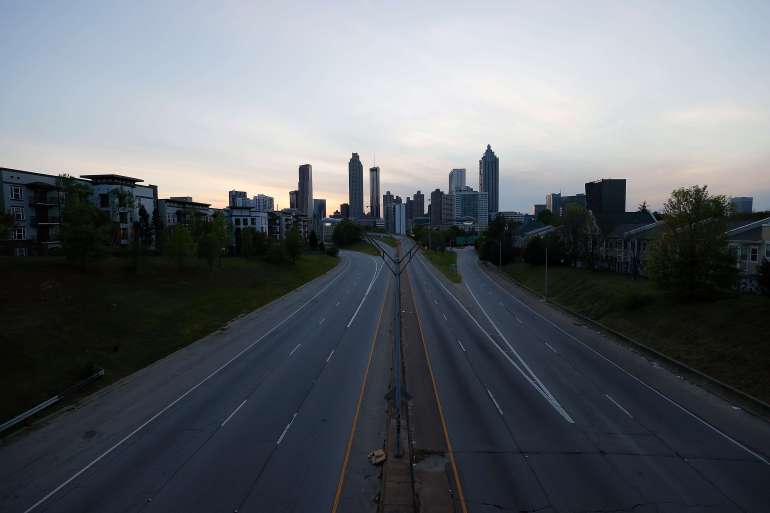
‘Stand still’
Many of the residents of the contested block in Peoplestown had initially vowed to stick together and fight the city, Bertha says. But after 2015, residents buckled, one by one, settled with the city and moved out.
“A lot of the residents in Peoplestown are senior citizens,” Bertha, an evangelist minister, explains. “They didn’t have the energy or the resources to fight the city and they gave up and left.”
“It was really hard for us,” she continues. “You would leave in the morning and a house would be there, and then you’d come back in the afternoon and the same house would be demolished into rubble.”
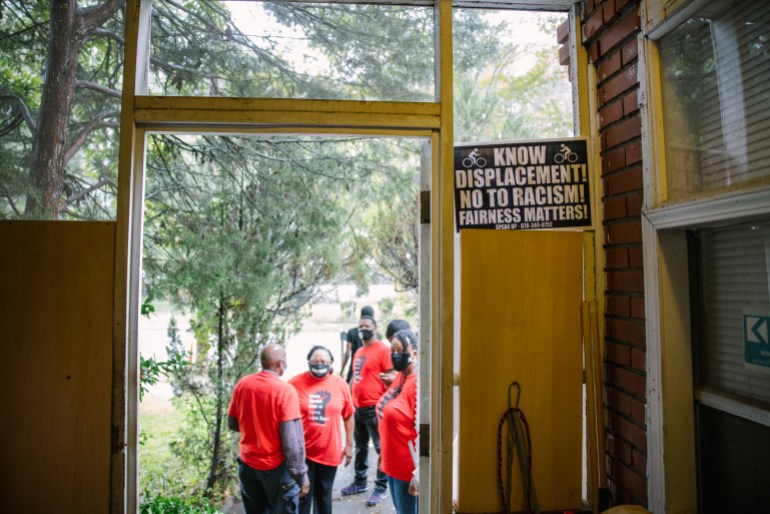
The rest of the neighbourhood, meanwhile, was aggressively pressured by private realtors to sell their homes, the prices of which are expected to dramatically jump in value after the construction of the pond and park. Residents continue to receive phone calls several times a week, regular emails and even real estate postcards that display pictures of their own houses, urging them to sell.
“You’re being targeted in this predatory process, and at the same time the neighbourhood is changing around you,” says Troutman, who has worked with the community in Peoplestown. “There’s something that weighs on your soul and spirit when you look up and everything you loved about your community has dried up – whether it’s the people you knew for years who are being displaced or the places you frequented that made the community a home for you.”
But “overwhelmingly it’s the pressures of being poor and the pressures of being trapped in an undervalued and underserved community that lead people to sell their homes,” Troutman adds. Private realtors will then flip the properties, selling them for sometimes double or triple the amount, residents say.
According to Robert, families in Atlanta are experiencing “intergenerational displacement,” and some of the residents who have recently been displaced from Peoplestown had settled into the community after gentrification pushed them out of Old Fourth Ward.
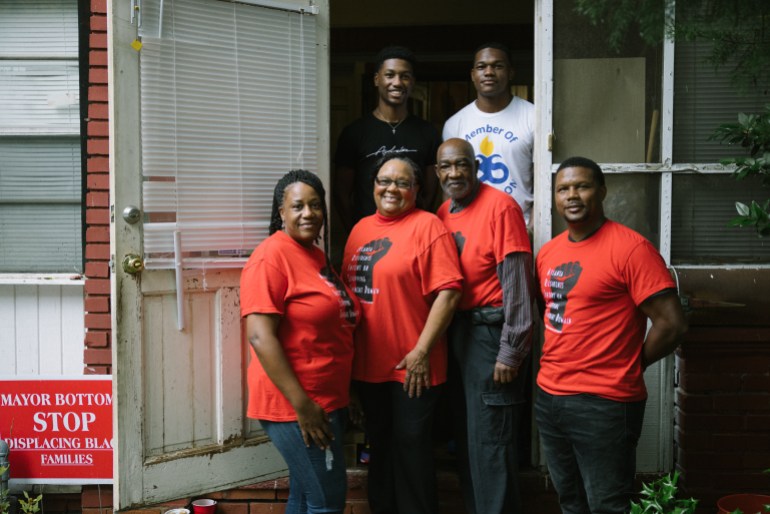
Bertha and Robert knew they had to make a decision – to pack up and leave or stay and fight. They had no reason to believe they would have a chance at winning and challenging the city would inevitably cause financial and mental hardships during what were supposed to be their golden years.
“We didn’t have the answer so we turned to God,” Bertha says.
They prayed for direction. “God spoke to my heart one night and told me to ‘stand still,’” Bertha says; she did not know that Robert had prayed and received the same answer that night.
“The next morning Robert came to me and held my hands and told me: ‘We’re in a fight and in order to win we got to stay in the fight. We need to stand still’,” Bertha recalls. “I was shocked. God had spoken to us and we were told clearly not to move.”
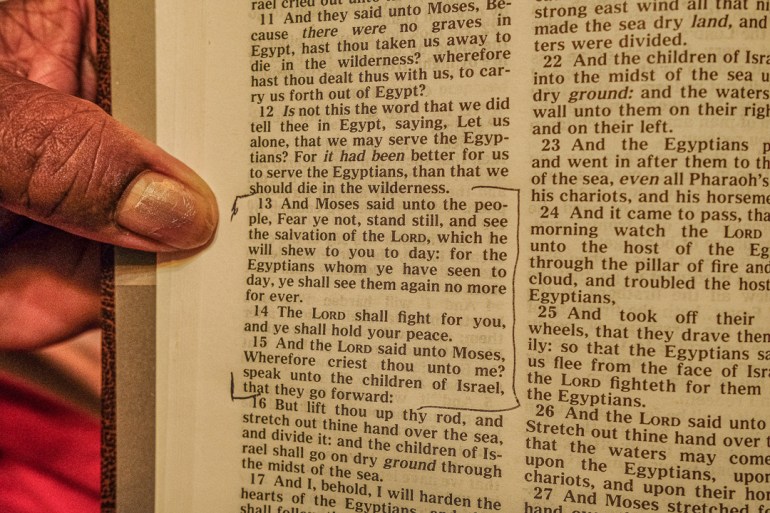
Bertha pauses from her story to grab a Bible from her living room table; she sifts through the pages until she finds the scripture that she and Robert had both read. Smacking her finger onto the page, she reads out loud: “And Moses said unto the people, Fear ye not, stand still, and see the salvation of the Lord, which he will shew to you to day: for the Egyptians whom ye have seen to day, ye shall see them again no more for ever.”
“The Lord shall fight for you, and ye shall hold your peace. And the Lord said unto Moses, Wherefore Criest thou unto me? Speak unto the children of Israel, that they go forward.”
This scripture is from the Book of Exodus in the Old Testament and describes the ancient Israelites’ deliverance from centuries of enslavement in Egypt.
“God told us to stand still. So why would I ever consider selling my house now?” Robert says. He speaks in a low, matter-of-fact tone. “I don’t care how much money they offer, I’m not selling. My father is already rich in houses and land. Thousands upon thousands of hills belong to Him. Their money means nothing to me.”
A continuation of the civil rights movement
The decision to stay and fight the city has not been easy for the Dardens. In 2016, the city sued the residents and condemned three of the homes. The perpetual anxiety of possibly being evicted and having their most cherished possession taken from them at any moment has weighed heavily on the couple.
“It’s been eight years of this now. It’s been up and down,” Bertha says. “But God comforts us through this, even though we have moments that make us want to lie down and cry.”
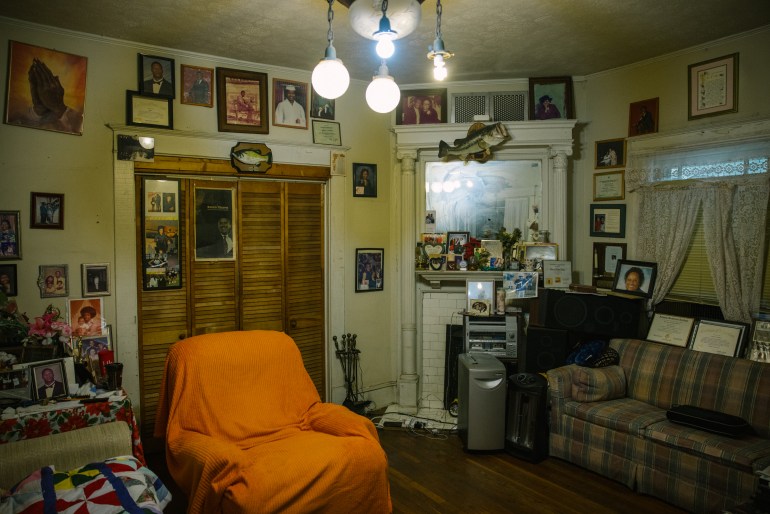
The Dardens and Washington tell Al Jazeera the city has also systematically harassed them since they refused to leave the block. In a repeat of what Ward described during the Great Recession, city code inspectors targeted the Dardens’ home. After being visited by code inspectors several times, Robert posted an officially stamped letter confirming their house had already passed a city code inspection onto the front door – in the hope of warding off future inspectors.
The city also sent a company to both the houses to shut their gas off to prepare for demolitions. “We all just happened to be home that day. But imagine if we weren’t?” Bertha says, incredulous. “They didn’t send us a letter or call us to warn us that this company is coming over to turn our gas off so our home can be demolished.”
“They just harass us,” she adds. “They are constantly trying to intimidate us. They really thought we’d just tire out and leave by now.”
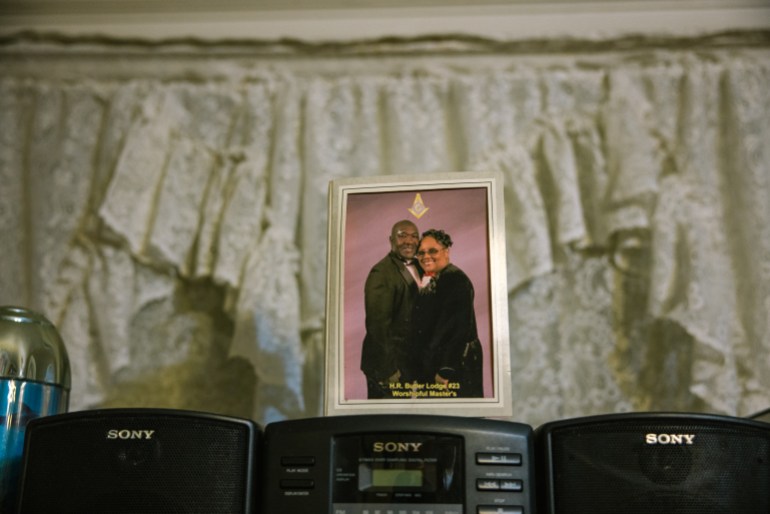
Police vehicles also often park directly outside their houses, they say, surveilling each end of the contested block. “We’ve never seen the police do this until we were sued by the city and started our fight,” Bertha says. “They still come a few times a month and just sit there watching our homes.” A spokesperson for the Atlanta Police Department denied this allegation.
Washington, who had stopped by the Darden’s home for a visit, interjects: “If this is another one of the city’s intimidation tactics, they will be disappointed because we’re not intimidated. I look at it as a positive – like wow, now we got the police protecting us.” She throws back her head and laughs.
Washington and the Dardens are also continuing to make payments on their mortgages even though their names have been removed from the title deed and replaced by the city of Atlanta. “I owe it to the bank so I have to pay. But I technically haven’t owned my home for years. The city owns it, but I’m still making payments on it,” Washington says.
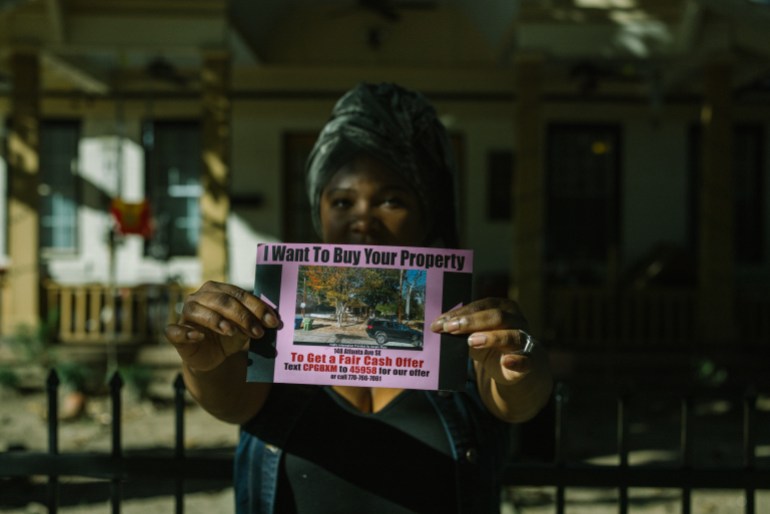
Robert says their decision to fight the city is a continuation of the civil rights movement. Their protest reaches far beyond the structure of their home, and interweaves with their ancestors who made the decision to fight before them.
“There’s nothing new under the sun,” Robert says with a shrug. “Generations before us had to go through this, so it’s really not anything new to us. I remember growing up as a child in Georgia and at that time segregation was normal. I remember going to some stores and restaurants that would have big signs saying ‘For Whites Only.’”
“My mother always taught me to depend on God and through that I was able to follow instructions and see beyond what was going on in front of me. This helped me and my struggle with all that was going on in the 60s,” he says.
“Now, 50 years later, we’re still going through things that we thought were behind us. And you can’t help but see it. But I’m not worried because I know who I am and I know whose I am. God is always in control. Satan don’t play fair. But my God don’t play at all.”
Robert leans forward, clasps his hands together, crosses his legs, and continues: “My mother was heavily involved in the civil rights movement and she taught me how to fight. It’s not just necessary for us. This fight is necessary for the generation that’s coming up. The generation before led us and now we have to lead the generation behind us.”
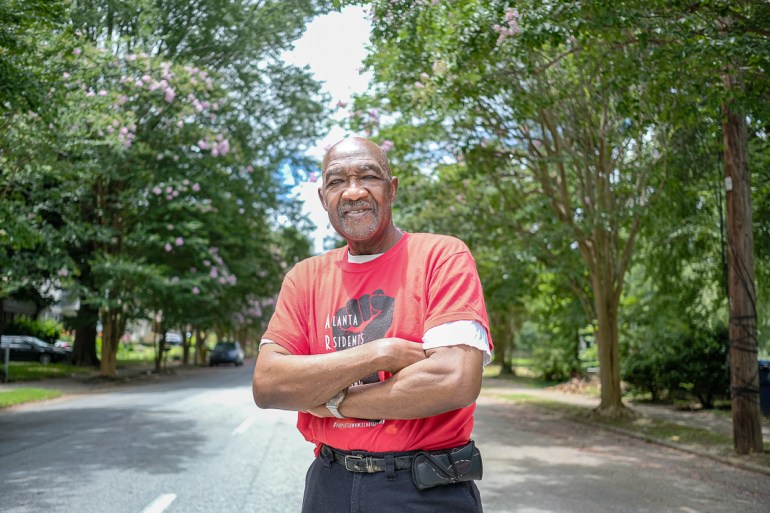
‘Evil is persistent’
In 2017, the residents on the block obtained emails they say prove their suspicions that the city was abusing eminent domain to further a green infrastructure project that was outside the scope of assuaging flooding in the neighbourhood.
In a series of emails from 2013, a city engineer who was managing the Peoplestown project, Kimberly Palmer – now Kimberly Scott – addresses the plans of Atlanta’s former watershed commissioner Jo Ann Macrina, who devised the pond and park project in Peoplestown.
As another city employee continuously states in the email thread, which was seen by Al Jazeera, Macrina “supports moving forward with the largest pond possible in Peoplestown,” Scott responds: “the present modeling results do not validate the need for a retention pond in Peoplestown […] the city doesn’t have technical data to support the proposed land acquisition and proposed design underway.”
Scott, the author of the emails, tells Al Jazeera that in the late 1990s, a federal judge issued consent decrees for combined sewage and sanitary sewer overflows after Atlanta was sued by a watchdog over pollution in the river and its tributaries owing to the lack of maintenance of its sewer system.
According to Scott, who had worked as an engineer for the city since 2007 and managed and designed several projects in response to federal consent decrees, the pond was being planned in Peoplestown in response to these consent decrees before the 2012 flooding as part of a multiphased project to mitigate flooding in and around the neighbourhood, which included the construction of permeable pavers and a stormwater detention vault.
Scott became the manager of the Peoplestown project after the 2012 flooding. “The city is mandated by the federal government under the federal consent decree to provide capacity relief and eliminate overflows due to Atlanta’s burdened and failing sewer system,” Scott says, which has caused localised flooding throughout the city.
“But I was taught to always minimise the impacts on residents and make sure you’re not displacing them with your engineering. You’re there to solve a problem, not create more problems,” she adds.
Scott tells Al Jazeera the pond was only supposed to be constructed around the junction box, which is the source of the overspills, and would have necessitated taking about four homes on the block. But before they were able to finalise the data, the footprint of the project was expanded to include the entirety of the now contested block.
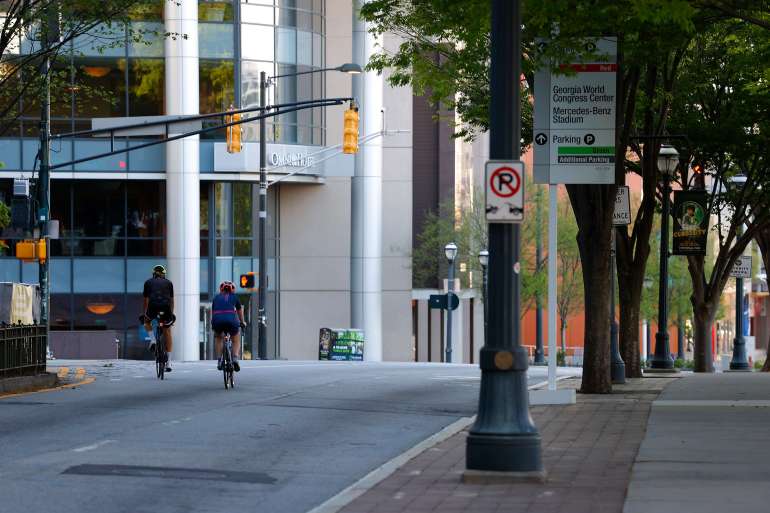
The city’s leadership, and in particular the Department of Watershed Management, “made the call to rush ahead with eminent domain for this project before getting finalised modelling analysis for the area to be able to better determine what the project needed to be,” Scott explains. “The city is only supposed to utilise eminent domain as its last recourse.”
“Part of my role and responsibility was to make sure we had final engineering data to best determine what needed to be done in the area – and that was not done,” Scott says.
“There was no data that justified going from what we thought was four homes at the low point where the flood happened to now a total of almost 25 homes,” Scott adds. “They were pushing ahead with a project that would displace a whole block of people for a green infrastructure project that had not been validated by engineering data.”
Scott says she tried to sound an alarm over the project. But in 2014 when she took her concerns to Macrina, her superior, she was swiftly fired. Two weeks later, the city pushed through the eminent domain ordinance.
Al Jazeera reached out to the city’s Department of Watershed Management for comment numerous times, but did not receive a response.
“It was environmental racism,” Scott tells Al Jazeera. “You’re providing an amenity that is supposed to be there for functionality and to solve an engineering problem. But now you’re using consent decree requirements that mandate fixing this issue to displace people and basically increase property values to bring a certain look and a certain socioeconomic status to the area.”
Macrina, meanwhile, has recently been charged with bribery, conspiring to commit bribery, and aiding and abetting the preparation of false income tax returns in an ongoing federal corruption investigation at city hall.
“We knew in our hearts and in our spirits that something was wrong, and this is why we were all somehow instructed to stay,” Washington says. “These emails were written before they demolished the first house. They knew they didn’t need to take the whole block and still went ahead and bulldozed people’s homes.”
According to Gary Spencer, the lawyer for the Dardens and Washington, the emails were obtained through discovery, but the city did not provide them until three days after the judge ruled in favour of the city, and buried them within tens of thousands of unrelated and jumbled documents.
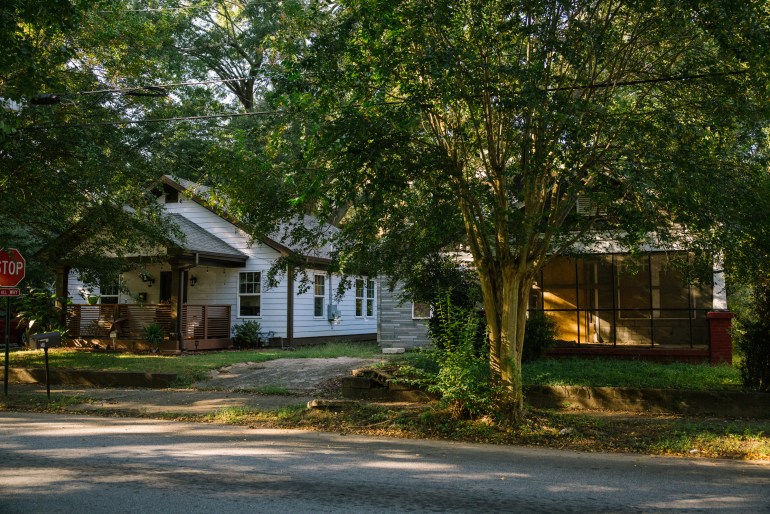
The residents now must conclude another hearing to determine just compensation, decided by a jury trial, before they can appeal the ruling, Spencer says. Owing to the COVID-19 pandemic, the trial is not expected to be scheduled any time soon.
Jeffrey House, from the engineering consulting firm House Moran which was hired by Washington and the Dardens, tells Al Jazeera that to this day the city has not provided the legal team with the hydraulic modelling and engineering data, which he says would have served as the basis for the city’s proposed project.
“I’m very confident that if they [the city] have the model justifying taking every single home on this block they would have shoved it in our face by now,” House says. “The fact that they’re not indicates they do not have the modelling to back any of this up.”
“This was a clear case of the city being a bully and trying to take advantage of Black people in the city,” he adds. “It was a sham process the city engaged in. They deliberately withheld information and tried to stifle the lawsuit every step of the way.”
After the email discovery in 2017, the residents thought the worst was over and the city would inevitably settle with them so they could stay in their homes. “The truth was lined up so it was undeniable,” Washington says.
But the new information has done nothing to deter the city’s goal of constructing the pond and park in the neighbourhood. “The corruption has continued,” Washington says. “The city is going on as if we don’t know that they’re lying. They won’t stop because they don’t want us to set an example for other residents facing displacement in the city.”
“Imagine how many other times the city has done something like this and ruined peoples’ lives,” she continues. “We are one small part of something much larger. We were just the first ones that fought long enough to piece things together.”
“But evil is persistent,” she says. “We’ve already experienced a partial victory now that the truth is out. Even if they come and bulldoze our homes and put us out on the streets, everyone will know that this was all done based on a lie.”
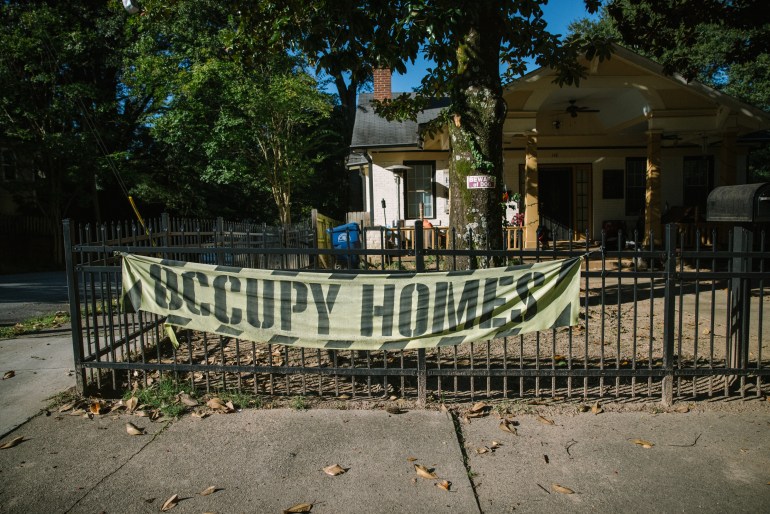
A meeting between the Dardens and Atlanta’s current mayor Keisha Lance Bottoms in April of last year to present House Moran’s alternative modelling that would provide a “win-win solution,” allowing the city to go ahead with their project without demolishing the four remaining homes, also proved fruitless – and the city has continued to march on with its initial plans.
Al Jazeera reached out to the city numerous times for comment on all of the allegations raised by residents in Peoplestown, including the city’s alleged harassment and its attempts to hamper the lawsuits, but did not receive a direct response. Al Jazeera also requested a comment from three lawyers representing the city, but they did not reply.
In response to Scott’s allegations, Michael Smith, a spokesperson at the mayor’s office, told Al Jazeera that Scott was “only involved in the early stages of the project” and that the hydraulic modelling has been refined since her dismissal which “continues to confirm that the project is very much needed to provide relief to the combined sewer system” in Peoplestown.
But the legal defence has still not been provided with this modelling, despite requesting these documents in discovery, House says. Al Jazeera also requested several times over the course of two months for the city to share its engineering modelling, but was not provided with these documents.
Smith says the city is “still pursuing the project in order to provide the necessary capacity relief to reduce the historic flooding. Courts have consistently decided in favour of the city’s efforts to strengthen the community’s water sewer infrastructure to prevent severe flooding.”
“The city never desires relocation as a solution, however these tough decisions are made in the best interests of the community as a whole for safety and protection of residents’ health and property.”
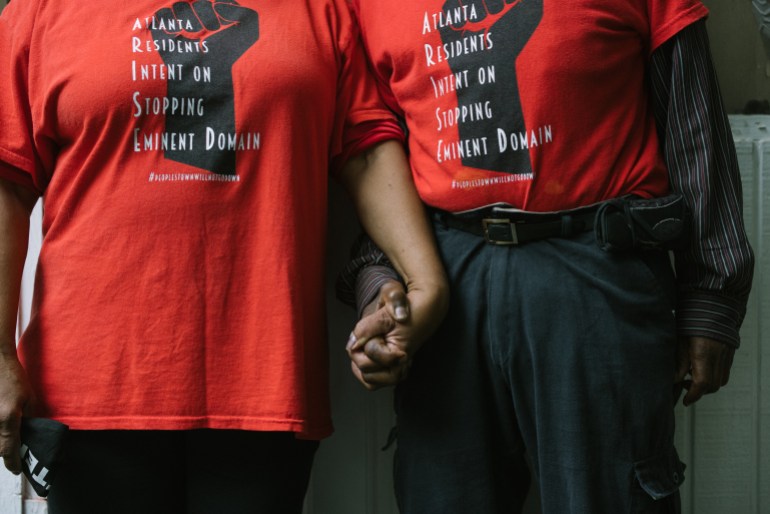
‘Mayor of Summerhill’
The streets of Peoplestown are lined with blooming crepe myrtles; the trees arch over the neatly paved roads, providing a partial umbrella for cars slowly cruising past colourful, multi-storey homes; the purplish petals fall off the branches and sprinkle the sidewalks.
For the new residents, these blossoming trees are likely a beautiful component of a neighbourhood that is promised to produce more attractive scenery once those four homes, still lingering and persistent, are finally demolished and the much-awaited pond and park constructed in their place.
But for the original residents of Peoplestown, including the steadfast few still living in those four homes on the contested block, these vibrant and budding trees are more than just an aesthetic addition to the neighbourhood’s streets; their soft pedals gently kiss the ground of Peoplestown, where the legacy of the neighbourhood’s late matriarch Mattie Ansley Jackson twists and turns like roots embedded deep in the soil.
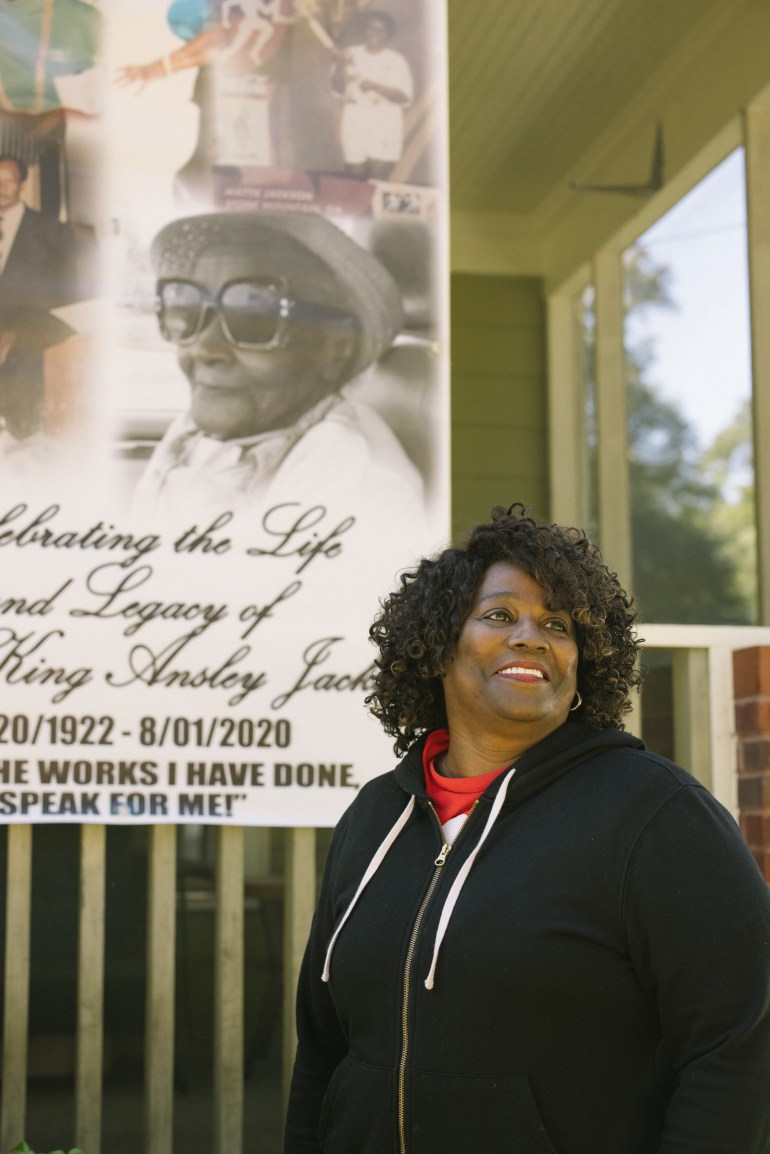
Jackson, who passed away in August at age 98, was a beloved member of the community and had lived in the neighbourhood for more than half a century. Her house is on Ormond Street, running parallel to Atlanta Avenue, on the other side of the contested block, which up until a few years ago was considered part of the Summerhill neighbourhood.
At just 14, she began what would become a lifelong commitment to community engagement and activism when she went door-to-door around Summerhill and collected money from residents to get them access to indoor plumbing and electricity.
She quickly became a powerful advocate for low-income and disadvantaged residents in Atlanta as she tirelessly pushed for community representation and worked to safeguard the interests of the city’s poor.
“She was a fighter,” Sheryl Calhoun, Jackson’s 62-year-old daughter, tells Al Jazeera from the porch of her mother’s home; on the front of Jackson’s brick house is a golden plaque dedicated to Jackson from the community, which states that her home will “forever remain a tribute to her service, her legacy and her leadership”.
“Despite her small frame, she was a powerful woman. She fought for people and she would help anyone who needed it,” says Calhoun, who grew up in Peoplestown. “All the mayors of Atlanta came through here to get my mom’s support and everyone in the neighbourhood would come over and ask my mom who they should vote for.”
Jackson, who earned the nickname “the mayor of Summerhill,” was selected as a member of the Atlanta Committee for the Olympic Games when the city was competing to host the Olympics, which she had hoped would bring improvements for the city’s residents.
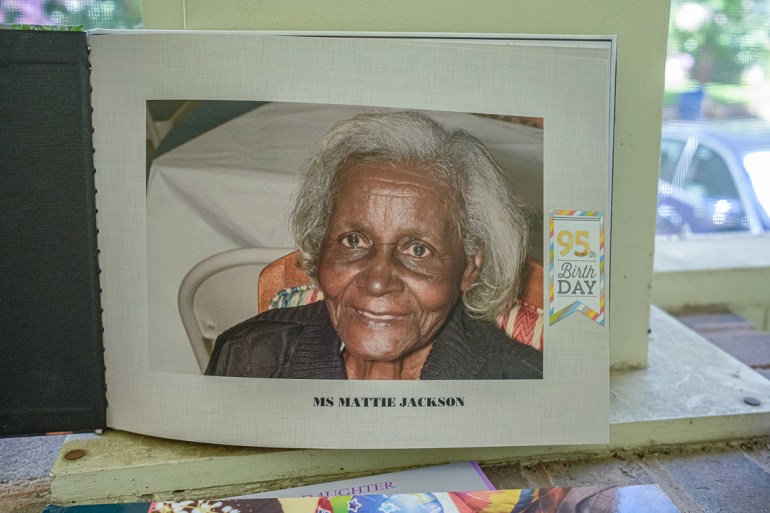
Jackson was chosen to attend the Olympics in Barcelona in 1992 to bring back ideas about how to improve Atlanta to host the games. It was in Barcelona where she got the idea to beautify the streets of Peoplestown and the surrounding neighbourhoods by planting crepe myrtle trees up and down the pavements.
Jackson also ran with the Olympic Torch in Atlanta during the 1996 games when she was in her 70s; little did she know that the promises of development and economic opportunities lauded by Atlanta’s leaders ahead of the Games would decades later cause the erosion of the neighbourhood she had dedicated her life to protecting.
When the city moved to take the block, Jackson stood tall with her neighbours and joined them in fighting the city – and continued to do so until she took her last breath. She knew the amount the city was offering for her house would leave her priced out of the area and displaced from the neighbourhood that served as the backbone of her identity and soul, Calhoun explains.
Like the other residents, Jackson believed “the city wasn’t being truthful,” Calhoun adds. But of all the years Jackson had spent standing up for the poor and downtrodden – marching boldly through segregation, the civil rights movement, and urban decay – it was the fight to save her home and neighbourhood that left some of the darkest and most painful bruising.
“She had to watch all the homes being demolished around her,” Calhoun explains. “It stressed her out so badly and it had a huge effect on her psychologically because she felt powerless to help her neighbours and she knew that any day she could be next.”
“This house is the centre of our family,” Calhoun adds. “This is Big Momma’s house. We have six generations that are all connected to this house. My mom used to tell the city: ‘you better move my house with me because there’s no way I’m leaving without my house.’”
Pushed into ‘early dementia’
In 2016, then-Mayor Kasim Reed announced that Jackson would be given special permission to stay in her home, noting that she has been a “pillar in her community,” and that the decision was made “out of respect for her contributions to her city.” The other residents, however, would still need to relocate.
“My mom knew they had only given her permission to stay because they thought she would die soon,” Calhoun explains, adding that Jackson had warned Reed at the time: “You think I’m going to die, but I’m going to outlive all of you.”
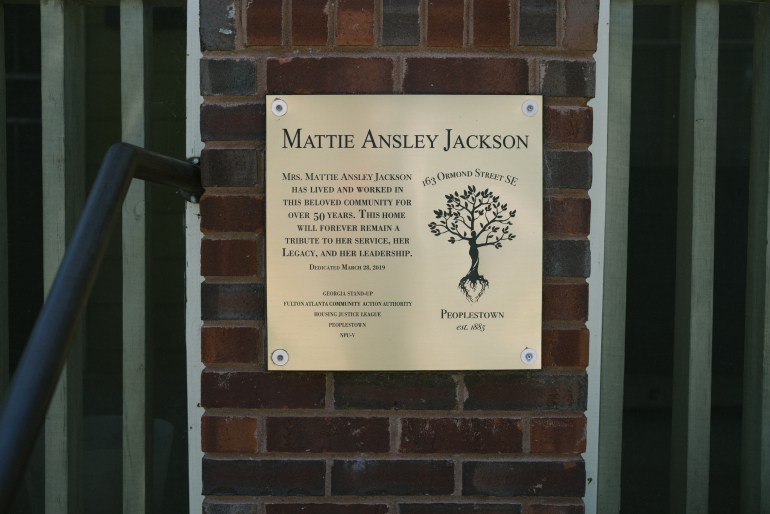
But instead of Jackson being able to relax, the decision to let her stay while her neighbours were facing evictions only placed more weight on Jackson’s shoulders. “She knew it was wrong and that it wasn’t fair,” Calhoun says. “How can you tell one person they can stay while everyone else has to leave? It just made all of it worse for her. But she kept going to the protests and supporting her neighbours’ fight against the city.”
Although Jackson was permitted to stay, her house was essentially made worthless, Don Evans, the lawyer who had handled Jackson’s legal case, tells Al Jazeera. The condemnation of Jackson’s home was approved at the same time as the other three remaining homes on the block; however, the city did not proceed in condemning her home after Reed’s decision and Calhoun’s name is now on the title.
“But they can’t get a loan on it and no one would buy a house whose condemnation has already been approved by the city,” Evans says. “The city has taken the family’s most valuable asset, encumbered it and made it impossible for them to get any value out of it.”
“The family just has to wait,” Evans adds. “In order for the property to be condemned, the city first has to get an attorney and file paperwork. But if the city doesn’t proceed then the house isn’t condemned. This is the limbo the Jackson family has been living under all this time.”
The stress of potential displacement and watching her neighbours’ homes crumble under the weight of bulldozers pushed Jackson into “early dementia,” Calhoun says. It was a trauma that followed her until her last days.
Inside Jackson’s home, a week before she passed away, piles of boxes sat in the living room and more were stacked tall in an adjacent room – as Jackson rested, sound asleep, on an in-house hospital bed.
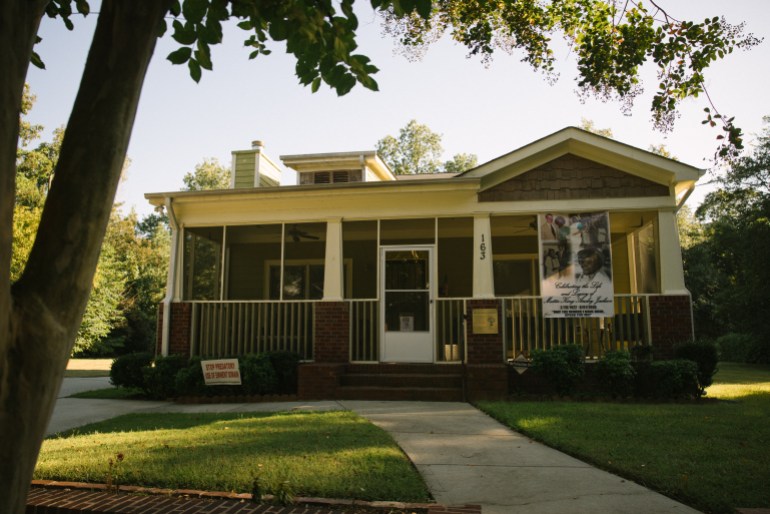
“When the dementia started and she was losing her memory and becoming more confused, she became obsessed with packing,” Calhoun says. “She was constantly pulling out suitcases and packing up all her belongings. We have boxes stacked up in all the rooms. She was convinced she was going to be evicted at any moment.”
“In her dementia, she would just suddenly turn to us and say: ‘They want my house.’ She would just bring it up all the time. If we brought her to the living room, she’d sit there and look around, and then ask: ‘This is my house, right?’ She would sometimes tell us: ‘Don’t you let them take my house. This is my house. I paid for this house.’”
Calhoun continues, her voice sharp and confident: “The city’s just been waiting around for my mom to die. But now they are going to have to fight me and I’m worse and even more stubborn than my mother.”
‘Jim Crow mentality’
Dwayne Adgar, 46, is the last unmovable resident on Peoplestown’s contested block. He lives next door to Jackson on Ormond Street. Blue paint peels down from the sides of his modest home, giving it a rundown look compared to the freshly painted tract homes and mini mansions taking over the neighbourhood.
Adgar bought his home 20 years ago and paid in cash, he says, because at that time banks would not issue home loans for the area. “Fast forward 10 years, and they’re giving white folks home loans, remodelling loans, this loan, that loan, get your house torn down and build another one on top of it loan,” Adgar says.
“Just a few years ago, we couldn’t do anything with our homes without paying cash,” he adds. “But get you a couple white folks in the neighbourhood and everything changes.”

Unlike the other residents on the contested block, Adgar is not entirely against settling with the city and parting with his home. But after years of negotiations, he has still not been offered what he considers to be fair compensation for his property.
“Dealing with the city of Atlanta, I’ve gotten a full history lesson on systemic racism,” Adgar tells Al Jazeera, as he takes a seat at a table on the porch outside his home. “They’re coming at me with this Jim Crow mentality like because I’m a Black man I don’t deserve to leave an inheritance to my family and I shouldn’t get a fair market rate – or I’m not intelligent enough to know the value of what I have.”
“If I settle for what they’re offering me right now, I’d be kicked out of the city,” Adgar adds. “They would turn me from a homeowner to a renter. Every commercial you see on TV is telling you to buy a home in America and that it’s the best investment you can make.”
“But when I do it, it has no value. If you’re going to gentrify this area then why not allow us to get some benefit from it just like everyone else? But for us they think we should be happy with these scraps the city is throwing at us.”
“And that’s why me and the city haven’t even come close to an agreement because the city is operating from this Jim Crow standpoint,” he continues. “They have a racist attitude towards me, and then that’s translated into the offers that the city makes me – and then they act like I’m being unreasonable. But if they’re not offering me enough to buy back into my own neighbourhood then what are we really talking about here?”
According to Evans, who is also representing Adgar, the city is offering Adgar about $250,000 for his home. Some houses around Adgar, meanwhile, are being sold from $400,000 to more than $600,000.
Evans explains that when the city condemned the homes, it estimated what it believed the houses were worth and deposited that amount into the court’s registry; the residents cannot access those funds without acquiescing to the city’s legal condemnation of their homes. However, the city, which now technically owns the homes, can.
Adgar took out a mortgage loan from Bank of America to do repairs on his home several years ago, which he was paying back in $200 monthly installments. After Adgar’s home was condemned and transferred to the city’s ownership, the city withdrew $50,000 from the funds in the court’s registry to pay off the rest of what was owed on the mortgage loan; now just $200,000 remains.
Adgar says he has also been tormented by the city. A few years ago, he received an eviction notice during the holidays, around Thanksgiving, that aimed to evict him by Christmas when many services are closed and it would be harder for Adgar to challenge the order. At the time, his two daughters, who are both now in their 20s, were living with him, but he sent them to live with relatives in Florida after the eviction notice.
“Who would want their kids to come home and see all of their stuff thrown out in the middle of the street? They made me feel like I could be evicted from my house at any moment,” Adgar explains.
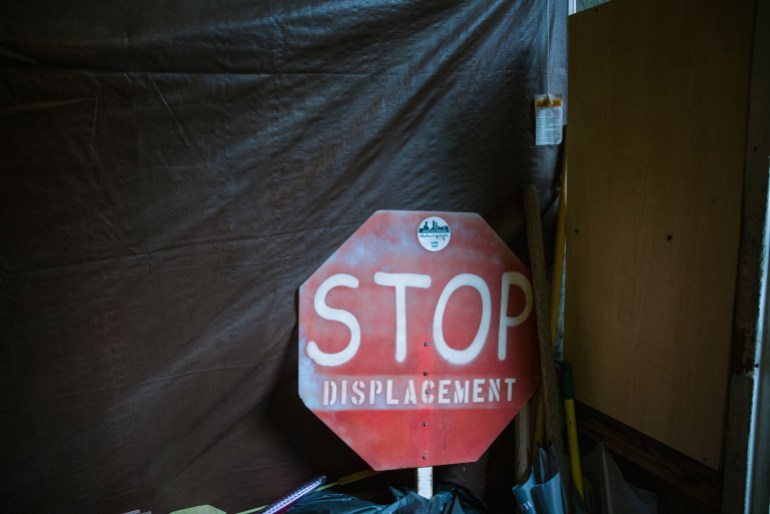
According to Evans, the city had nearly demolished Adgar’s home in 2015 while bulldozing other homes on the block, forcing Evans to rush to get a temporary court injunction.
Last month, the city filed a motion of contempt, requesting the court order the immediate eviction of Adgar owing in part to him not paying rent to the city for three years. Evans and Adgar tell Al Jazeera the city did not inform them he was expected to pay rent during this time.
“The city can end the legal argument by evicting Adgar and simply bulldozing his house and it appears that’s what they’re trying to do,” Evans tells Al Jazeera. “If we’re raising the legal issue of the condemnation of Adgar’s home, and for some reason the Adgar home disappears, it’s no longer a legal issue.”
“So if the city is able to evict Adgar, they would be free to make the Adgar home disappear and essentially end the legal fight with a bulldozer,” he adds.
The motion also requested the city be provided the three years of backed up rent it says Adgar owes to them – the amount of which would be determined based on the rental value of the property. This undetermined amount would be withdrawn from the $200,000 left in the court’s registry, which would have been provided to Adgar if he lost his appeal – and thus his home.
“They want to kick him out and keep all the money, too,” Evans explains. “The city is attempting to reduce Adgar from a proud homeowner in the city of Atlanta to a homeless person.”
The city’s renewed attempt to evict Adgar has also come amid the global COVID-19 pandemic, which has killed hundreds of thousands of Americans, and despite a federal moratorium on evictions. The Dardens and Washington are also expecting the city will similarly move to evict them soon. Earlier this month, the Dardens received a letter from the city warning of further actions, which Spencer says preempts an eviction notice.
“It’s outrageous behaviour,” Evans tells Al Jazeera. “It’s hard to describe this behaviour of city officials to their own citizens as anything else but inhumane. It shocks the conscience that they would try and push someone out of their home in the middle of a pandemic.”
Assortments of moving boxes, stacked on top of one another, also line the inside of Adgar’s home; about 90 percent of his belongings have been boxed up and packed away for at least four years now, Adgar says, in case the city moves to expel him.
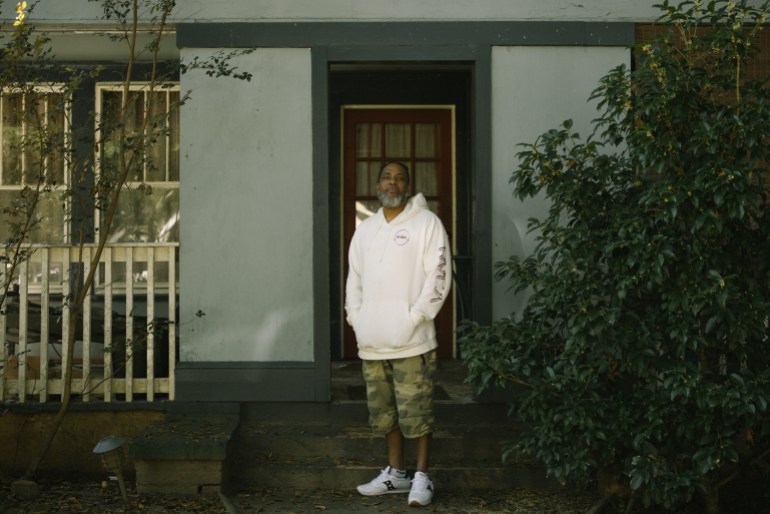
“It gets unsettling and nerve-wracking over time,” Adgar tells Al Jazeera; heaviness and exhaustion seem to drift behind his eyes. “You want to do work and invest in your house and make it a home. But how can I put work into a home that I don’t own any more and that the city can just come and knock down like they did all the others?”
“It feels like you’re living in a tenement yard or in a camp because nothing is yours. You spent years working to own a home and after all that you don’t own anything.”
But Adgar does not think the city’s behaviour is unique, or even surprising. “They’re coming from a position of racial authority,” he reflects. “They’ve always short-changed Black people; they know if they just make them mad enough or exhaust them or wait them out long enough, eventually those Black people will have financial problems and then they’ll come and take their property. This is what they’ve done for years.”
Erasing a community
Calhoun’s anger and bitterness is palpable. “This used to be a neighbourhood. We all knew each other,” she says. “You’d come outside and wave and talk to each other. We helped each other out. We had a community.”
She remembers the summer months when the children of Peoplestown played on the streets and hung out on Jackson’s stoop; they ran from house to house, chatting to each other through screen doors. When the humid Georgia heat cooled down in the evenings, the streets of Peoplestown would come alive, as residents sauntered outside to converse, laugh and socialise.
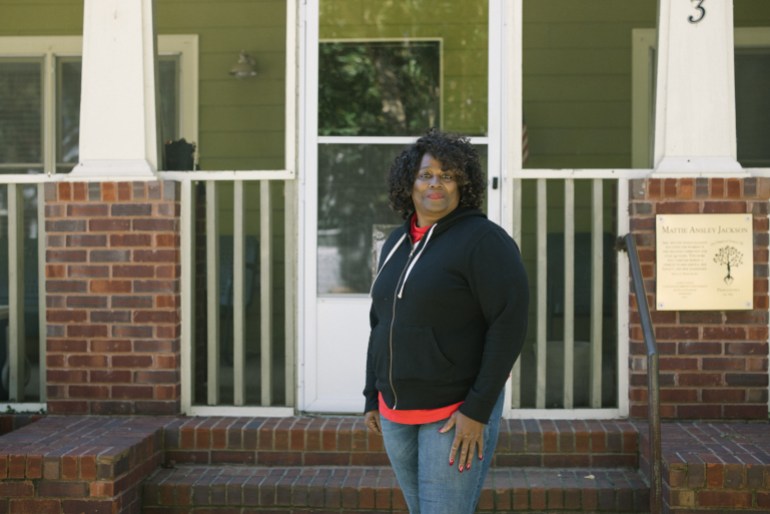
“All of that’s gone now,” Calhoun reflects. “They took a neighbourhood and they turned it into a hood. There’s no sense of community now.”
The residents say they often face antagonism from some of the newcomers trickling into the neighbourhood. “They look at us like we don’t belong here,” Calhoun says, gesturing to the homes across the street. “Some of them can’t wait until they tear our houses down and get to walk their dogs in their little park. They act like us being here for 50 years is somehow interfering with their lives.”
Calhoun’s irritation is understandable; not only is this planned project, which is supposed to curb flooding that residents in Peoplestown have complained about for decades, not meant for them, it necessitates their erasure from the neighbourhood – and possibly from the city of Atlanta.
“The pond and park are supposed to increase the value of the homes,” Washington says. “So they [the new residents] want us gone so they can live next to Japanese walking trails, a gazebo and a waterfall. A lot of them are liberal. You see them walking with Black Lives Matter signs and going to the protests.”
“But when you talk to them about who should be in their neighbourhood and who shouldn’t be and what’s standing between them and a higher property value, that’s when their true colours start to show,” she adds.
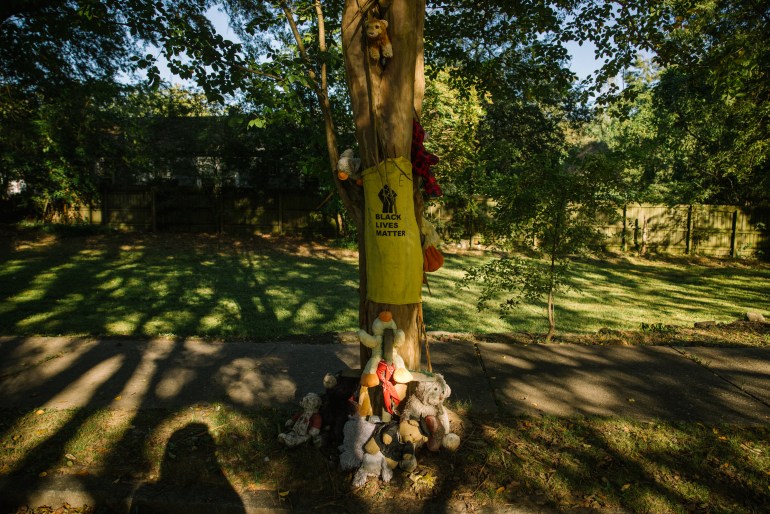
Some of the newcomers directly blame the remaining residents on the contested block for the continued flooding issues in the neighbourhood. “The city could have fixed the flooding a long time ago,” Adgar says. “But the city made the conscientious decision not to, so they could make us look more like enemies to our neighbourhood and community.”
“Now when it rains and floods our neighbours don’t look at the city, they look at us like us not moving is the reason for all of these flooding issues. The city is trying to paint it up as these problems being our fault because we won’t leave.”
Peoplestown has also faced an uptick in police activity, Ward says, because the new residents “are always calling the police for no reason”.
“If a group of young Black men are walking together, they’ll assume they’re up to no good and call the police,” he tells Al Jazeera. “They assume our young people are criminals or they’re engaging in criminal activity without knowing them at all.”
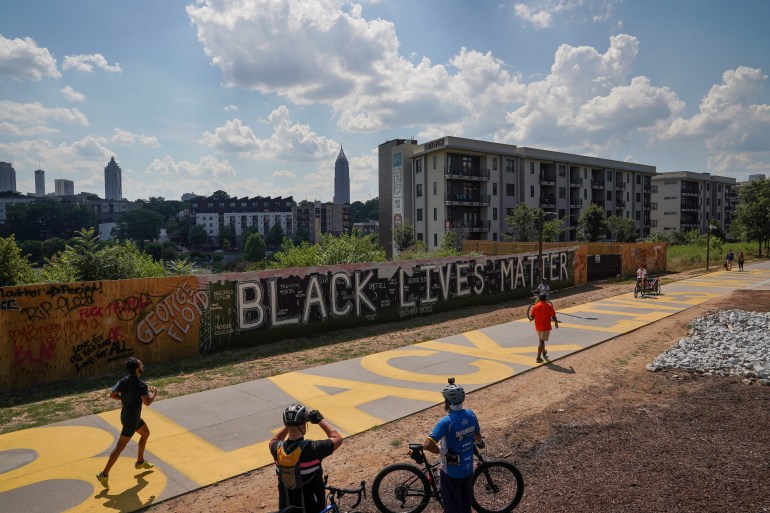
Fifty-four years after Prather’s body crumbled to the pavement, yet another unarmed Black man’s blood stained the streets of Peoplestown. In June, someone called the police on Rayshard Brooks, a 27-year-old father, after he fell asleep in his car at a Wendy’s drive through, located near the contested block. Brooks, who was intoxicated, ran away from police when they tried to arrest him; Garrett Rolfe, a white police officer, chased after Brooks and shot him in the back, killing him.
Protests and riots erupted following the shooting; the neighbourhood, which has been gasping for breath under the weight of decades of urban renewal and gentrification, once again became engulfed in plumes of tear gas and smoke as grieving protesters set alight the Wendy’s and burned it to the ground.
The homes on the contested block in Peoplestown look insignificant, almost powerless, compared to the vast green area surrounding them, which sits calmly, waiting for the remaining residents to be expelled so it can finally swallow their homes.
But the residents’ fight has not only thrust a thorn into the city’s development plans in the neighbourhood; they have angrily stomped their feet on a system of racial injustice that has ripped through countless Black lives across the United States – leaving trails of displacement, dispossession, pain and death in its wake.
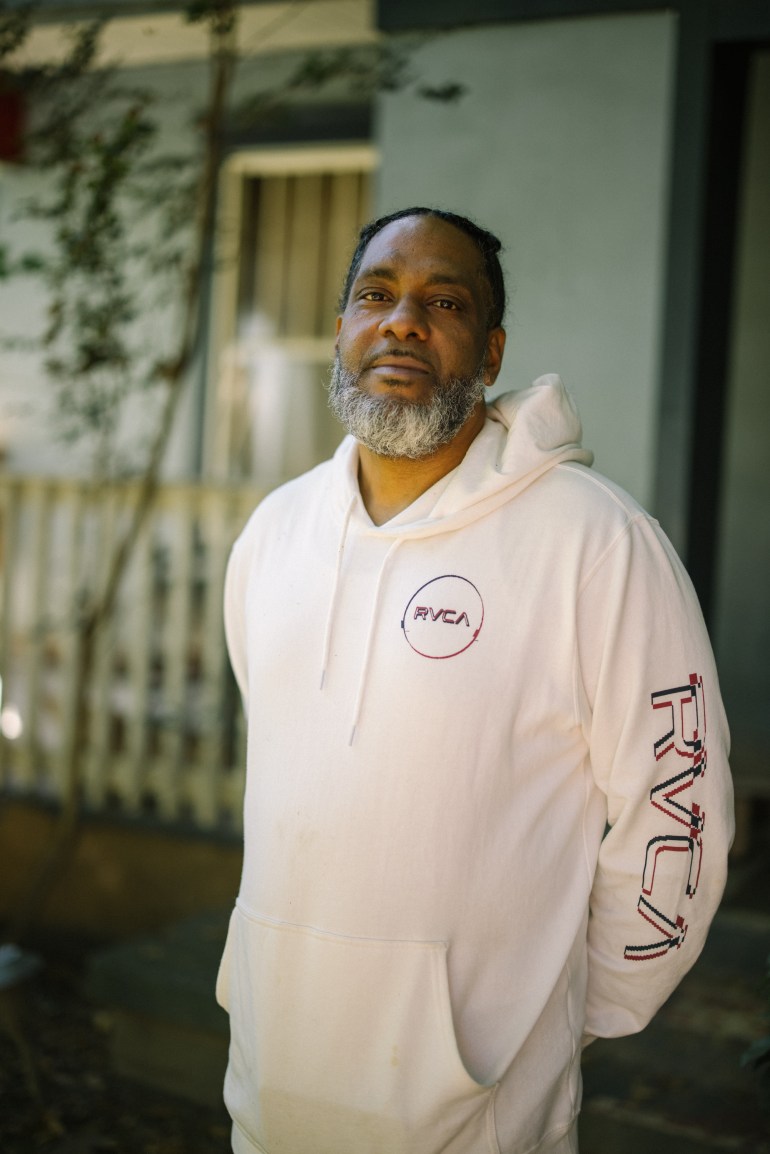
Despite the long road ahead and the neighbourhood transforming around them, often making them feel like strangers in their own community, the stubborn residents are not giving up. And for some, like Adgar, not all the changes in the neighbourhood have been negative.
“I like some of what they’ve done in the area,” he says. “I’m not against change. But the thing that I don’t like is they are trying to make sure that I am no longer a resident of this new city of Atlanta.”
“We’re not part of their plan at all. We’re in the way of their plan,” he adds. “They’re trying to make sure there are no remnants of the old neighbourhood and there’s no one left who remembers what it was like before – as if the contributions our local heroes, like Mattie Jackson, made to this neighbourhood don’t matter at all. They won’t stop until the whole neighbourhood and our history are erased and white-washed over.”